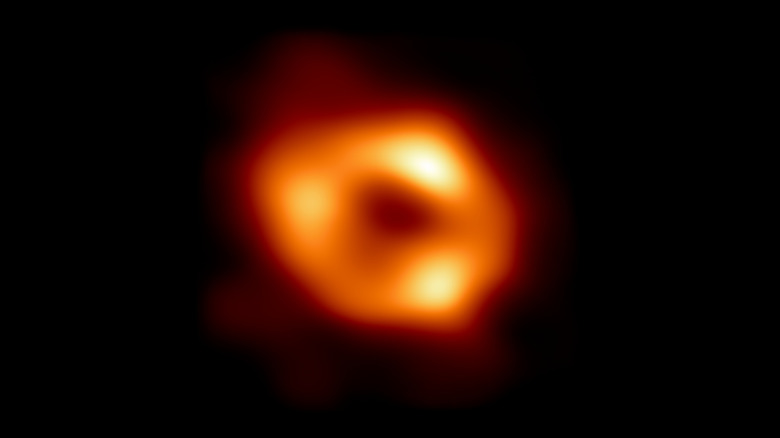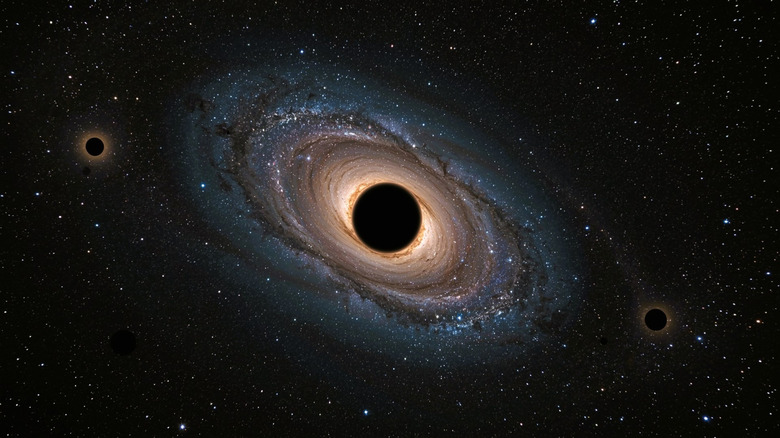Why Our Solar System Shouldn't Fall Into Our Galaxy's Black Hole
Our galaxy, the Milky Way, is home to multiple wonders. There is our biggest star, VY Canis Majoris, the column-like structures known as the Pillars of Creation, and, in the middle of it all, a supermassive black hole known as Sagittarius A*. Black holes are a bit mysterious, and we are still trying to fully understand how they form. Black holes have gravity so strong they can pull in even the light around them, thus the adjective "black" in the name. This has led some to wonder if Earth itself may one day end up as a victim of Sagittarius A*. Don't worry, it won't happen any time soon.
Even though our galactic black hole is 4.3 million times as massive as the sun, its gravitational influence on us is miniscule compared to the overall density of the galactic core. Consider that the sun comprises over 99% of the mass of the solar system and we've been spinning along for a few billion years without any major incidents. Sagittarius A*, on the other hand, comprises less than 1% of the mass of the entire galaxy. That's how inconsequential its gravity is to us.
Although Sagittarius A* is currently considered a dormant black hole, it has been known to eat matter that comes too close in the past, but seeing as how we're 27,000 light-years away, getting too close isn't something we need to worry about. But just because we don't have to worry about being consumed by our galactic core, there is a theory that Earth (and the universe) may already be inside a black hole and we just don't know it.
The details of our galaxy's black hole
Scientists discovered Sagittarius A* in 1974, but we only got our first image of it in 2022 after a five-year effort involving a global team of 300 researchers from 80 organizations. Scientists actually had an easier time taking an image of M87* in 2019, which is a much bigger black hole in the Messier 87 galaxy. This is due to the gas orbiting Sagittarius A* very quickly, making taking a clear image difficult.
While Earth shouldn't fall victim to the black hole, it has been known to consume matter in the past. Scientists are able to determine if a black hole has consumed anything based on it giving off energy in the form of X-rays and infrared light. Researchers study these flares to determine how material falls into a black hole. Astronomers have even been able to look at reflections of X-ray light in the galactic core to determine the last time Sagittarius A* had a large meal about 200 years ago.
Sagittarius A* is considered a supermassive black hole, and those are more common than originally thought. Extremely dense and extremely heavy, their great mass causes distortions in the space around them. Though difficult to spot, more and more research has uncovered greater numbers of these supermassive black holes in the universe. Luckily, Sagittarius A* is the closest one uncovered to Earth so we can keep an eye on any danger it poses.
Is Earth already inside a black hole?
So, while our solar system shouldn't fall into Sagittarius A*, there are some that claim we may already be inside a black hole. This theory is known as Schwarzschild cosmology, and it suggests that the universe as we know it was born inside of a black hole, and that there is a larger universe outside of our own.
Nikodem Poplawski, a theoretical physicist from Indiana University, advocates for this theory. "Our universe could have itself formed from inside a black hole existing inside another universe," he told Space.com. "In my model, when the universe is born, there is no problem of having a singularity initially — instead of being infinitely small, it had the radius of its parent black hole." In other words, black holes may not be the ultimate end of all things, rather, they could be the beginning of everything.
While posing a unique idea, this theory has a long way to go before being proven. For now, scientists focus on learning all they can about black holes — such as finding a black hole that should not exist — and studying the one in our own Milky Way galaxy, Sagittarius A*.


